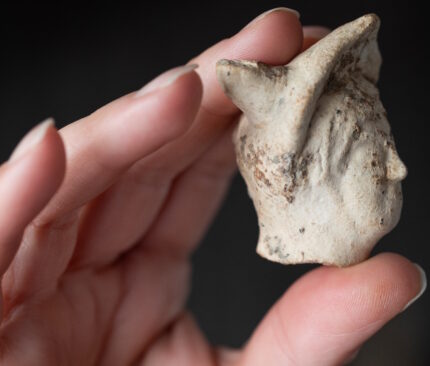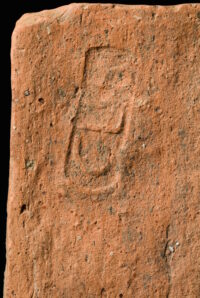 An excavation of a medieval shipbuilding site in the hamlet of Smallhythe, near Tenterden in Kent, has revealed a previously unknown Roman settlement occupied between the 1st and the 3rd centuries. One of the artifacts from the Roman settlement is an exceptionally rare figurine of the head of the god Mercury made from pipeclay. Fewer than 10 pipeclay Mercury figurines from Roman Britain are known.
An excavation of a medieval shipbuilding site in the hamlet of Smallhythe, near Tenterden in Kent, has revealed a previously unknown Roman settlement occupied between the 1st and the 3rd centuries. One of the artifacts from the Roman settlement is an exceptionally rare figurine of the head of the god Mercury made from pipeclay. Fewer than 10 pipeclay Mercury figurines from Roman Britain are known.
The figurine head is two inches tall. It was broken off at the neck, but would originally have had a body.
Religion was a central part of daily life in most Roman provinces, and statues as well as portable figurines of gods like the one discovered at Smallhythe were worshipped by both the Roman elite and the ordinary citizens in their homes.
Pipeclay figurines were made of clays local to central Gaul (modern-day France) and the Rhine-Moselle region and were imported, however most pipeclay figurines found in Britain are of female deities, the majority being of Venus.
This complete figurine probably would have depicted Mercury standing, either draped with a chlamys (a short cloak), or naked, holding a caduceus (a staff with two intertwined snakes).
Smallhythe today is 10 miles from the sea, but when the settlement was founded in the 1st century it was a port town. It was small compared to the major urban center of Roman Britain, but was a significant link in the chain of ports that together formed Rome’s import and export network in southern England. Timber and iron were exported out of the province to the continent and finished products were imported.
 One of the other finds made in the excavation confirms the town’s role: a tile stamped “CLB,” an abbreviation of Classis Britannica, Rome’s provincial naval fleet. The Classis Britannica was not a military navy. Its job was to manage the transportation of materials, people and communications in the English Channel.
One of the other finds made in the excavation confirms the town’s role: a tile stamped “CLB,” an abbreviation of Classis Britannica, Rome’s provincial naval fleet. The Classis Britannica was not a military navy. Its job was to manage the transportation of materials, people and communications in the English Channel.
The pipeclay Mercury head and CLB tile will go on display with other artifacts recovered from the site starting February 28th at the Smallhythe Place museum.